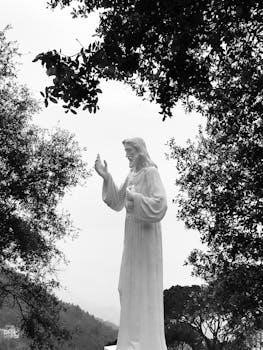The Bible presents a detailed lineage from Adam to Jesus, tracing God’s plan through generations. This genealogy, often visualized in charts and timelines, highlights key figures and their roles in salvation history. Understanding this lineage offers insight into the fulfillment of prophecies.
Overview of Biblical Genealogies
Biblical genealogies are more than lists of names; they are a vital part of the narrative, demonstrating God’s faithfulness through generations. These family trees, as found in both the Old and New Testaments, reveal the historical context of key events and individuals, particularly highlighting the lineage leading to Jesus. Tracing the ancestry from Adam to Jesus emphasizes the continuity of God’s covenant and promises. The structure and importance of these genealogies vary, often emphasizing specific theological points or historical connections. Examining them provides a deeper understanding of the Bible’s message.
Adam to Noah Lineage
This section explores the direct line from Adam, the first man, through to Noah; Key figures include Seth, Enos, and Methuselah, illustrating early human history and God’s plan.
Key Figures⁚ Adam, Seth, Enos, Cainan, Mahalalel, Jared, Enoch, Methuselah, Lamech, Noah
This lineage begins with Adam, the first man, followed by Seth, born after Cain’s transgression. Enos, Cainan, Mahalalel, and Jared continue the line. Enoch stands out, being raptured by God. Methuselah, known for his long life, is followed by Lamech and then Noah, who was instrumental in the Noahic covenant. Each ancestor plays a part in the story from creation to the flood, showcasing the timeline of early biblical history and lineage.

The Noahic Covenant and the Flood
The Noahic covenant marks a new beginning after the flood. Noah’s obedience ensured the survival of humanity and animals. This event is pivotal in understanding the lineage from Adam to Jesus.
Noah’s Role in the Genealogy
Noah is a crucial figure in the genealogy, bridging the pre-flood world to the post-flood era. His lineage continues through his sons, Shem, Ham, and Japheth, with Shem’s line being significant for the lineage of Abraham and eventually Jesus. Noah’s righteousness and obedience, which led to the survival of his family and the animal kingdom, is a significant event. It is a pivotal moment in the biblical narrative, demonstrating God’s judgment and mercy. His role emphasizes the continuity of God’s plan.
Shem’s Lineage and the Path to Abraham
Shem’s lineage is a critical part of the biblical narrative, tracing the path from Noah to Abraham. This line establishes the ancestry of the patriarchs and the chosen people of God.
Connecting Noah to Abraham
The lineage connecting Noah to Abraham is crucial in understanding the biblical narrative. This segment of the family tree showcases the continuation of God’s covenant and the gradual unfolding of His plan for humanity. Key figures like Shem are vital links in this chain, demonstrating how the post-flood world progressed toward the establishment of the covenant with Abraham. It highlights the preservation of a godly line despite the widespread wickedness that led to the flood, ultimately leading to the birth of the father of nations and the chosen people.

Abraham and the Patriarchs
Abraham, Isaac, Jacob, and Judah form a vital segment. These patriarchs are central to the lineage leading to the Davidic line and, ultimately, Jesus. Their stories reveal God’s covenant promises.
Abraham, Isaac, Jacob, and Judah
Abraham, the father of faith, initiated the lineage, followed by Isaac, who carried the covenant. Jacob, later named Israel, became the father of the twelve tribes, and from his son Judah came the royal line. These figures are pivotal in God’s plan, establishing a hereditary line through whom the Messiah would descend. Their stories, filled with both faith and human fallibility, lay the foundation for the promised lineage. These patriarchs are key to understanding the connection to David and ultimately Jesus in the Bible’s family tree.
The Lineage from Judah to David
The line from Judah leads to King David, a pivotal figure in Israel’s history. This lineage is crucial as it establishes the royal and messianic line that leads to Jesus.
Key Figures in the Davidic Lineage
Key figures in the Davidic line include Boaz, who married Ruth, and their son Obed, who was the father of Jesse. Jesse, in turn, fathered King David, a shepherd chosen by God to rule Israel. David’s reign is a critical point in the genealogy as it establishes the royal line from which the Messiah would descend. This lineage is important because it ties Jesus to the promised kingdom of David, highlighting the fulfillment of God’s covenant. The genealogy emphasizes the importance of lineage in Jewish tradition and God’s faithfulness.

The Genealogy of Jesus in Matthew and Luke
Matthew and Luke provide two genealogies of Jesus, differing in their approach. Matthew traces Jesus’ lineage from Abraham, while Luke goes back to Adam. These accounts highlight different aspects of Jesus’ identity.
Comparison of the Two Gospels’ Genealogies
The genealogies in Matthew and Luke present distinct perspectives on Jesus’ ancestry; Matthew’s account emphasizes Jesus’ legal right to the throne of David through Joseph, his adoptive father, starting with Abraham. Luke, on the other hand, traces Jesus’ lineage back to Adam, highlighting his humanity and connection to all of mankind. While the lists are identical from Abraham to David, they diverge after that point, reflecting different purposes and theological viewpoints. These variations offer a rich and complex understanding of Jesus’ heritage and divine nature.
Key Women in the Lineage
Several women, like Tamar, Rahab, Ruth, and Bathsheba, play crucial roles in Jesus’ lineage. These women, despite their varied backgrounds, are vital to God’s plan of salvation.
Highlighting Important Female Figures
The lineage of Jesus includes women whose stories are essential to understanding the narrative. Tamar, through her courageous actions, ensured the continuation of the line. Rahab, a woman of Jericho, demonstrated faith that integrated her into the genealogy. Ruth, a Moabite, showed loyalty, becoming an ancestor of David. Bathsheba, though her story includes pain, is part of this sacred lineage. These women, with their diverse backgrounds and actions, highlight God’s grace and his inclusive plan, showing the importance of women in God’s plan.
Significance of the Genealogy
The genealogy of Jesus demonstrates his legitimate claim to the throne of David. It highlights the fulfillment of Old Testament prophecies, linking Jesus to the lineage promised to Abraham and his descendants.
Understanding the Importance of the Lineage to Jesus
The lineage from Adam to Jesus is crucial because it establishes Jesus’s historical and genealogical connection to the promises made by God to Abraham and David. This demonstrates that Jesus was not an arbitrary figure, but rather the fulfillment of God’s plan through a specific line of descent. The detailed genealogies found in the Gospels of Matthew and Luke underscore this point, showcasing Jesus’s rightful place within the history of Israel and his claim as the Messiah, emphasizing the importance of his heritage.
Adam to Jesus Charts and Timelines
Visual aids, like charts and timelines, are invaluable for grasping the Adam to Jesus lineage. These resources often include names, dates, and key events, making the family tree easier to understand.
Available Resources⁚ Wall Charts and PDF Downloads
Numerous resources are available for those seeking to explore the Adam to Jesus genealogy. Large wall charts, often featuring over 1000 names and fascinating facts, provide a comprehensive visual overview. These charts are useful for both individual study and group instruction. Additionally, downloadable PDF versions offer a convenient and portable way to access the same information. Some charts include reproducible worksheets and teaching tips, enhancing their educational value. These resources come in various formats including dry erase and laminated options, catering to different preferences and needs.

The Significance of the Family Tree
The Adam to Jesus genealogy is crucial, demonstrating God’s faithfulness and the fulfillment of His promises through Jesus’ lineage. It connects the Old Testament to the New Testament, highlighting salvation history.
Summarizing the Importance of the Adam to Jesus Genealogy
The genealogy from Adam to Jesus, meticulously recorded in Scripture, underscores the continuity of God’s redemptive plan. It establishes Jesus’ rightful place as the Messiah, linking him directly to the lineage of David and ultimately to Adam. This detailed family tree is not merely a historical record; it is a powerful testament to God’s faithfulness throughout generations. Understanding this lineage provides profound insights into the fulfillment of biblical prophecy and the overarching narrative of salvation. It also connects us to the human history of Jesus, confirming His role as both fully God and fully man.



